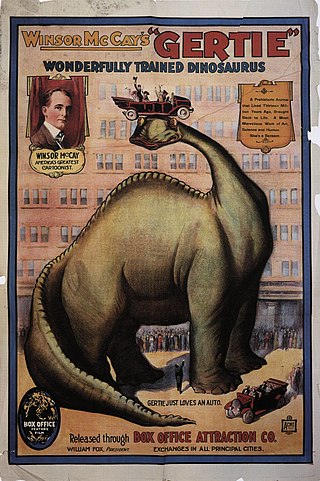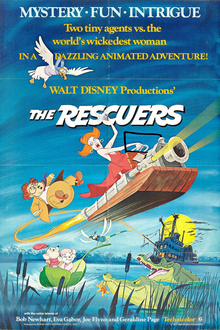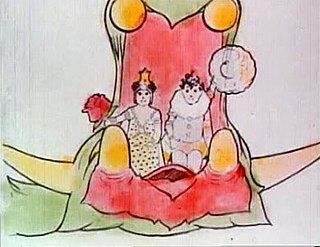Related Research Articles

Gertie the Dinosaur is a 1914 animated short film by American cartoonist and animator Winsor McCay. It is the first animated film to feature a dinosaur. McCay initially presented the film before live audiences as an interactive part of his vaudeville act; the frisky, childlike Gertie performed tricks at her master's command. McCay's employer William Randolph Hearst curtailed his vaudeville activities, prompting McCay to add a live-action introductory sequence to the film for its theatrical release, which was renamed Winsor McCay, the Famous Cartoonist, and Gertie. McCay abandoned a sequel, Gertie on Tour, after producing about a minute of footage.

Limited animation is a process in the overall technique of traditional animation that reuses frames of character animation.

Zenas Winsor McCay was an American cartoonist and animator. He is best known for the comic strip Little Nemo and the animated film Gertie the Dinosaur (1914). For contractual reasons, he worked under the pen name Silas on the comic strip Dream of the Rarebit Fiend.

One Hundred and One Dalmatians is a 1961 American animated adventure comedy film produced by Walt Disney Productions with distribution by Buena Vista Distribution. Adapted from Dodie Smith's 1956 novel The Hundred and One Dalmatians, the film was directed by Hamilton Luske, Clyde Geronimi, and Wolfgang Reitherman in his feature-length directorial debut, from a script by Bill Peet. It features the voice talents of Rod Taylor, J. Pat O'Malley, Betty Lou Gerson, Martha Wentworth, Ben Wright, Cate Bauer, Dave Frankham, and Fred Worlock.

The Rescuers is a 1977 American animated adventure comedy-drama film produced by Walt Disney Productions and released by Buena Vista Distribution. Bob Newhart and Eva Gabor respectively star as Bernard and Bianca, two mice who are members of the Rescue Aid Society, an international mouse organization dedicated to helping abduction victims around the world. Both must free 6 year old orphan Penny from two treasure hunters, who intend to use her to help them obtain a giant diamond. The film is based on a series of books by Margery Sharp, including The Rescuers (1959) and Miss Bianca (1962).

Marc Fraser Davis was a prominent American artist and animator for Walt Disney Animation Studios. He was one of Disney's Nine Old Men, the famed core animators of Disney animated films, and was revered for his knowledge and understanding of visual aesthetics. After his work on One Hundred and One Dalmatians he moved to Walt Disney Imagineering to work on rides for Disneyland and Walt Disney World before retiring in 1978.
John Cannizzaro Jr., better known as John Canemaker, is an American independent animator, animation historian, author, teacher and lecturer. In 1980, he began teaching and developing the animation program at New York University, Tisch School of the Arts', Kanbar Institute of Film and Television Department. Since 1988 he has directed the program and is currently a tenured full professor. From 2001-2002 he was Acting Chair of the NYU Undergraduate Film and Television Department. In 2006, his film The Moon and the Son: An Imagined Conversation, a 28-minute animated piece about Canemaker's relationship with his father, won the Academy Award for best animated short. In 2007 the same piece picked up an Emmy award for its graphic and artistic design.

Wolfgang Reitherman, also known and sometimes credited as Woolie Reitherman, was a German-American animator, director and producer. As a member of the "Nine Old Men" at Walt Disney Productions, Reitherman was known for his action-oriented animation.

The Sinking of the Lusitania (1918) is an American silent animated short film by cartoonist Winsor McCay. It is a work of propaganda re-creating the never-photographed 1915 sinking of the British liner RMS Lusitania. At twelve minutes, it has been called the longest work of animation at the time of its release. The film is the earliest surviving animated documentary and serious, dramatic work of animation. The National Film Registry selected it for preservation in 2017.

Kenneth B. "Ken" Anderson was an American animator, art director, and storyboard artist for The Walt Disney Company. He had been named by Walt Disney as his "jack of all trades".

Gustaf Adolf Tenggren was a Swedish illustrator and animator. He is known for his Arthur Rackham-influenced fairy-tale style and use of silhouetted figures with caricatured faces. Tenggren was a chief illustrator for The Walt Disney Company in the late 1930s, in what has been called the Golden Age of American animation, when animated feature films such as Snow White and the Seven Dwarfs, Fantasia, Bambi and Pinocchio were produced.
101 Dalmatians may refer to:

How a Mosquito Operates is a 1912 silent animated short film by the American cartoonist Winsor McCay. The six-minute short depicts a giant mosquito tormenting a sleeping man. The film is one of the earliest works of animation, and its technical quality is considered far ahead of its time. It is also known under the titles The Story of a Mosquito and Winsor McCay and his Jersey Skeeters.

Disney's Nine Old Men were a group of Walt Disney Productions' core animators, who worked at the studio from the 1920s to the 1980s. Some of the Nine Old Men also worked as directors, creating some of Disney's most popular animated movies from Snow White and the Seven Dwarfs to The Rescuers. The group was named by Walt Disney himself, and they worked in both short and feature films. Disney delegated more and more tasks to them in the animation department in the 1950s when their interests expanded, and diversified their scope. Eric Larson was the last to retire from Disney, after his role as animation consultant on The Great Mouse Detective in 1986. All nine members of the group were acknowledged as Disney Legends in 1989 and all would receive the Winsor McCay Award for their lifetime or career contributions to the art of animation.

Winsor McCay: The Famous Cartoonist of the N.Y. Herald and His Moving Comics, more commonly known as Little Nemo, is a 1911 silent animated short film by American cartoonist Winsor McCay. One of the earliest animated films, it was McCay's first, and featured characters from McCay's comic strip Little Nemo in Slumberland. Its expressive character animation distinguished the film from the experiments of earlier animators.

101 Dalmatians is an American media franchise owned by The Walt Disney Company and based on Dodie Smith's 1956 novel The Hundred and One Dalmatians. It began in 1961 with the release of the traditionally animated feature film, One Hundred and One Dalmatians. Various adaptations produced from Disney have been released over the years.

Barrier-grid animation or picket-fence animation is an animation effect created by moving a striped transparent overlay across an interlaced image. The barrier-grid technique originated in the late 1890s, overlapping with the development of parallax stereography (Relièphographie) for 3D autostereograms. The technique has also been used for color-changing pictures, but to a much lesser extent.
Events in 1914 in animation.
Events in 1892 in animation.
Events in 1871 in animation.
References
- ↑ Hopwood, Henry V. (August 21, 1899). "Living pictures; their history, photoproduction and practical working. With a digest of British patents and annotated bibliography". London Optician & Photographic Trades Review – via Internet Archive.
- ↑ Berthier, Auguste (May 16 and 23, 1896). "Images stéréoscopiques de grand format" (in French). Cosmos34 (590, 591): 205–210, 227-233 (see 229–231)
- ↑ Timby, Kim (May 1, 2001). "Images en relief et images changeantes. La photographie à réseau ligné". Études photographiques (9): 124–143 – via journals.openedition.org.
- ↑ "Marjorie Bennett Dead at 87; Acted in Chaplin's 'Limelight'". The New York Times . 22 June 1982. Retrieved 6 September 2010.
- ↑ Sharp, Jasper (September 23, 2004). "Pioneers of Japanese Animation (Part 1)". Midnight Eye. Retrieved 12 December 2009.
- ↑ Official booklet, The Roots of Japanese Anime, DVD, Zakka Films, 2009.
- ↑ Scheerhout, John (12 September 2002), "Honour for 'Dalmatians' Dodie", Manchester Evening News , retrieved 14 January 2010
- ↑ Smith, Dodie (2018). The Hundred and One Dalmatians & The Starlight Barking – Modern Classics. About The Author: Egmont UK Ltd. ISBN 978-1-4052-8875-0.
- ↑ "10 Things You Didn't Know About 101 Dalmatians". Oh My Disney. "2. The story is based on Dodie Smith's own experience". c. 2015. Retrieved 7 December 2019.
{{cite web}}: CS1 maint: location (link) - ↑ "One Hundred and One Dalmatians (1961)". AFI Catalog of Feature Films . American Film Institute. Archived from the original on January 2, 2024. Retrieved January 2, 2024.
- ↑ Giesen, R.; Storm, J.P. (2012). Animation under the swastika: a history of trickfilm in Nazi Germany, 1933-1945. Jefferson, North Carolina: McFarland & Company. pp. 153–156.
- ↑ Bendazzi, G. (2015). Animation: A world history. Volume I: Foundations – the golden age. London: Focal Press. pp. 240–256. doi:10.4324/9781315721057. ISBN 978-1-317-52083-2 . Retrieved 2 February 2016.
- ↑ Klatt, O. (9 May 2013). "Animated Success: The Life of Germany's Own Walt Disney". Der Spiegel. Retrieved 28 January 2016.
- ↑ Moritz, W. "The Case of Hans Fischerkoesen". www.awn.com. Retrieved 6 January 2016.
- ↑ Canemaker, John (2005). Winsor McCay: His Life and Art . Harry N. Abrams, Inc. p. 47. ISBN 0-8109-5941-0.
- ↑ Bob McCay at the Lambiek Comiclopedia
- ↑ McCay, Bob at Bails, Jerry, and Hames Ware, Who's Who in American Comic Books 1929–1999
- ↑ "The Untold Story of Argentina's Pioneer Animator". www.awn.com. Retrieved May 29, 2020.
- ↑ Brook, Marisa. "Drawing the Shorter Straw". Damn Interesting. Retrieved 19 September 2018.
- ↑ Giannalberto Bendazzi (Anna Taraboletti-Segre, translator); Cartoons: One Hundred Years of Cinema Animation; Indiana University Press; ISBN 0-253-20937-4 (paperback reprint, 2001)
- ↑ "Gustaf Tenggren's World". www.gustaftenggren.com. Retrieved May 20, 2020.
- ↑ "GUSTAF A. TENGGREN, CHILDREN'S ARTIST". The New York Times. 9 April 1970. Retrieved 2018-11-05.
- ↑ Conrad, JoAnn. Fantasy Imaginaries and Landscapes of Desire: Gustaf Tenggren’s Forgotten Decades
- ↑ John Canemaker, Before the animation begins : the art and lives of Disney inspirational sketch artists, New York : Hyperion, 1996 ISBN 978-0-7868-6152-1
- ↑ "Jim Jordan, Radio's Fibber McGee, Is Dead at 91". Associated Press in the New York Times . 2 April 1988. Retrieved 2009-08-08.
Jim Jordan, who delighted audiences for two decades as the well-meaning but bumbling Fibber McGee in the classic radio show Fibber McGee and Molly, died today at the Beverly Hills Medical Center. He was 91 years old. Mr. Jordan had been hospitalized for more than a week, in a coma with a blood clot in his brain caused by a fall at his home, according to a family friend, the radio and television performer Fran Allison. Mr. Jordan never regained consciousness after the accident.
- ↑ "The Rescuers Down Under". Disney Archives. Disney.go.com. Archived from the original on January 29, 2007. Retrieved January 2, 2016.
- ↑ Hansen, Kathryn (1 December 2013). Stages of Life: Indian Theatre Autobiographies. Anthem Press. pp. 10, 16, 19, 292, 338. ISBN 978-1-78308-068-7.
- ↑ Hansen, Kathryn (1998). "Stri Bhumika: Female Impersonators and Actresses on the Parsi Stage". Economic and Political Weekly. 33 (35): 2291–2300. JSTOR 4407133 – via Academia.